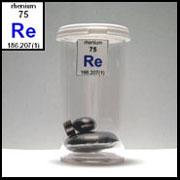Atomic number | 75 |
Atomic mass | 186.23 g.mol -1 |
Electronegativity | 1.9 |
Density | 20.5 g.cm-3 at 20°C |
Melting point | 3170 °C |
Boiling point | 5627 °C |
Vanderwaals radius | 0.138 nm |
Ionic radius | unknown |
Isotopes | 9 |
Electronic shell | [ Xe ] 4f14 5d5 6s2 |
Energy of first ionisation | 759 kJ.mol -1 |
Standard potential | 0.25 V ( ReO2/ Re ) |
Discovered by | Walter Noddack in 1925 |
Rhenium is a silvery metal but rarely seen as such on account of its high melting point, which is the third highest after carbon and tungsten. Rhenium is very hard, it resists corrosion but slowly tarnishes in moist air.
Applications
Rhenium is used as an important component in superalloys for blades in turbine engines and this is the major use today. Rhenium is an ideal metal for use at very high temperatures, which makes it suitable for rockets motors. Rhenium is added to tungsten and molybdenum to form alloys that are used as filaments for ovens and lamps. It is also used in thermocouples which can measure temperatures above 2000 C, and for electrical contacts which stand up well to electric arcs.
Rhenium, alloyed with platinum, was used in petroleum-reforming catalysis in the production of high-octane hydrocarbons, used for lead free gasoline.
Other applications are rhenium-tungsten alloys in X-raytubes and rotating X-ray anodes. Rhenium-molybdenum alloys are superconductors at a temperature of 10K. Rhenium has occasionally been used for plating jewerly.
